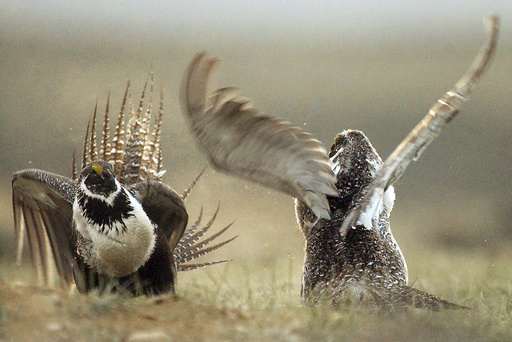
President Joe Biden’s administration has announced a plan to impose stricter regulations on the development of oil, solar, and wind energy across more than 6,500 square miles of federal land in the Western United States in order to safeguard a declining bird species, the greater sage grouse.
However, the future of these measures is uncertain, particularly with the potential changes in leadership as Donald Trump remains a strong advocate for expanding energy exploration.
The greater sage grouse, which resembles a small chicken and is recognized for its complex mating rituals, has seen a significant decline in its population over the past few decades due to various threats including energy development, wildfires, and disease.
A crucial agreement reached in 2015 under the Obama administration helped to keep the sage grouse off the endangered species list by limiting where and when energy projects could take place within their expansive 270,000-square-mile habitat range.
Now, officials at the Interior Department are seeking to strengthen these protections further. Their proposal includes closing loopholes that permitted certain types of development in vital areas essential for the long-term survival of the species. Newly proposed solar and wind projects would not be allowed in these regions, while oil and gas drilling would be restricted to platforms situated outside the protected zones.
During his presidency, Trump promoted the concept of maximizing energy development on public lands, adopting a slogan of “drill baby drill.” His administration previously attempted to overturn the sage grouse protections that were established during the Obama years, but these efforts faced legal challenges.
Secretary of the Interior Deb Haaland asserted that the new proposal would enhance protections for the sage grouse while still permitting some degree of development on federal lands. She emphasized that the framework was developed based on the most current scientific understanding of the species’ needs.
Haaland further remarked on the need for a balance between land management strategies, arguing against the false notion that development must be at odds with conservation efforts.
Nevertheless, the administration’s proposal did not receive unanimous support, encountering criticism from environmental advocates, industry representatives, and Republican officials.
Approximately 4,700 square miles of the proposed restrictions are concentrated in Nevada and California, though affected areas also extend into Wyoming, Oregon, Idaho, Colorado, Montana, and parts of the Dakotas.
Wyoming Governor Mark Gordon criticized the federal administration for what he regarded as a lack of concern for his state, contending that the new regulations would complicate practical solutions for managing the sage grouse. He emphasized that Wyoming had demonstrated effective methods to protect the bird while also facilitating responsible development.
Environmental groups expressed disappointment, arguing that the administration had failed to seize a crucial opportunity to implement adequate protections that could prevent the sage grouse’s dwindling numbers from reaching a critical state. They pointed out that loopholes permitting continued development would remain across nearly 50,000 square miles of public land.
Greta Anderson, a representative from the Western Watersheds Project, noted that while the proposed changes might be less severe than previous regulations, they still represented ongoing harm to the species. “It’s death by a thousand cuts,” she stated, criticizing the administration for not taking more decisive action.
Federal representatives have indicated that they anticipate minimal economic repercussions resulting from the new proposal. They stated that energy companies generally avoid sage grouse habitats due to existing limitations regarding work near breeding sites.
However, this viewpoint was contested by Kathleen Sgamma of the Western Energy Alliance, who argued that the Biden administration’s restrictions had already limited energy leasing in sage grouse territories.
Protests regarding the proposal will be accepted by the Bureau of Land Management until December 9, and final decisions regarding land management adjustments will follow the resolution of these protests.
Another initiative related to sage grouse protections seeks to impose a 20-year ban on new mining projects across more than 15,625 square miles in states including Idaho, Montana, Nevada, Oregon, Utah, and Wyoming. This proposal was part of the previous Obama-era protections, which were lifted under Trump but later reinstated by court order.
The Interior Department plans to release an analysis of the mining ban by the end of the year. Historically, greater sage grouse populations numbered in the millions across parts of 11 Western states, but according to federal scientists, their numbers have fallen by 65% since 1986.
